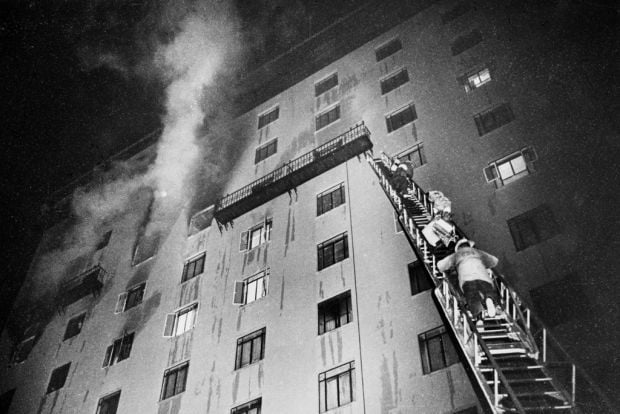Attorneys hoping to win a new trial for a Tucson man accused of killing 29 people in the 1970 Pioneer Hotel fire say an investigator with the Tucson Fire Department recently reviewed all of the available evidence in the case and wasn't able to determine what caused the blaze.
"No reasonable jury would have convicted" Louis Cuen Taylor if they had been privy to investigator Wayne Cummings' findings, Taylor's attorneys say in recently filed court documents.
But Deputy Pima County Attorney Rick Unklesbay, however, said the original fire investigator still believes the fire was purposely set, and the TFD investigator who recently reviewed the evidence didn't have access to a great deal of evidence because it's been destroyed.
On Dec. 20, 1970, more than 750 people were packed into the Pioneer Hotel at Stone Avenue and Pennington Street in advance of the holidays.
While people were dancing to live music on the ground floor, a fire broke out on the fourth floor and raced its way to the top of the 11-story building.
The first floor's doors were locked because of prior vandalism, and the firetrucks' ladders couldn't reach the upper floors.
According to news accounts of the blaze, a few guests climbed down a fire-escape tower, but others leapt from windows.
In the end, four people died in the street; seven were burned to death; 17 died of carbon-monoxide poisoning; and one died nine months later of injuries suffered during the fire.
Taylor, then 16, was arrested immediately and convicted in 1972 after a seven-week trial and sentenced to 28 concurrent life terms.
Last October, attorneys with the Arizona Justice Project filed a motion for post-conviction relief, asking for the case to be dismissed or for an evidentiary hearing.
The attorneys, including Michael Piccarreta of Tucson and former Arizona State Supreme Court Justice Stanley Feldman, said several defense experts, using modern science, would testify they would not have ruled the fire arson.
The defense team also alleged prosecutors engaged in misconduct by not giving defense attorneys a laboratory report that said no accelerants were found and by talking to the judge without defense attorneys present.
They further said a detective behaved unethically by speaking with a juror who was dismissed before the trial was over. During the conversations, the juror told the detective which remaining jurors were subject to influence, which were "wishy-washy" and which had minds of their own.
On Feb. 28, the defense attorneys submitted an undated report by Cummings, who was asked to look at the case by prosecutors using current fire investigation methodology. Cummings was asked for his expertise because the fire took place in the city; he was not paid for his services, Unklesbay said.
Although it's possible other documentation was once available, Cummings wrote in his report that he studied all of the audio, video, electronic and paper-based documents that were found in the archives of the Tucson Police Department, Tucson Fire Department and Pima County Attorney's Office.
Because it's unknown exactly where the fire started and because of the "lack of elimination of all accidental fire causes, a fire cause determination is not possible reviewing the material provided to me."
Cummings went on to write that the situation was further complicated by the fact that he couldn't examine the actual fire scene and had to interpret post-fire patterns from "inconsistent photographs."
Piccarreta was elated by the report.
"We're happy that the city of Tucson Fire Department has joined six other experts in concluding that the cause of the Pioneer fire was undetermined. Without an arson determination, there cannot be an arson conviction," Piccarreta said Wednesday morning. "Mr. Taylor has for the last 42 years adamantly professed his innocence, and this report adds to the overwhelming weight of the evidence questioning whether an arson ever occurred."
Prosecutors have until March 25 to respond in writing to the defense motion.
However, Unklesbay made it clear Wednesday afternoon that the defense experts and Cummings are not saying the fire wasn't arson - they are saying they can't determine what caused the fire.
In addition, much of the evidence in the case was destroyed in the 1990s or disappeared after civil attorneys took possession of it when they sued the hotel, Unklesbay said.
Lastly, Unklesbay said in addition to the original investigator standing by his original report, there was other evidence presented at the 1972 trial that indicated the fire was arson.
The original investigator, who was hired by the state to testify at Taylor's trial, continues to work in his field in California, Unklesbay said.
Pima County Superior Court Judge Richard Fields is presiding over the case.
Contact reporter Kim Smith at 573-4241 or kimsmith@azstarnet.com







